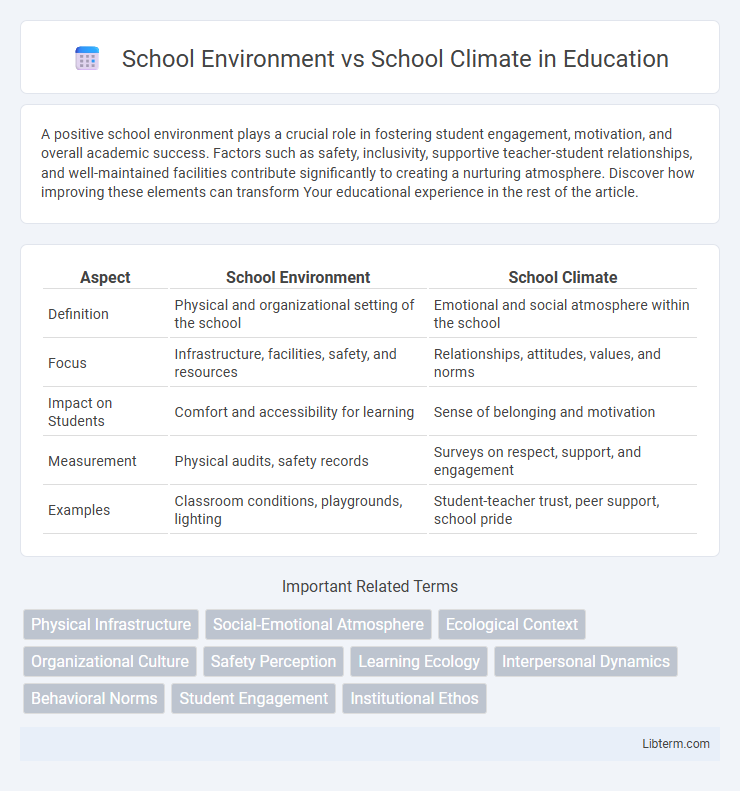A positive school environment plays a crucial role in fostering student engagement, motivation, and overall academic success. Factors such as safety, inclusivity, supportive teacher-student relationships, and well-maintained facilities contribute significantly to creating a nurturing atmosphere. Discover how improving these elements can transform Your educational experience in the rest of the article.
Table of Comparison
| Aspect | School Environment | School Climate |
|---|---|---|
| Definition | Physical and organizational setting of the school | Emotional and social atmosphere within the school |
| Focus | Infrastructure, facilities, safety, and resources | Relationships, attitudes, values, and norms |
| Impact on Students | Comfort and accessibility for learning | Sense of belonging and motivation |
| Measurement | Physical audits, safety records | Surveys on respect, support, and engagement |
| Examples | Classroom conditions, playgrounds, lighting | Student-teacher trust, peer support, school pride |
Defining School Environment and School Climate
School environment refers to the physical, social, and organizational settings within a school, including facilities, safety measures, and relationships among students, teachers, and staff. School climate encompasses the collective perceptions, attitudes, and feelings about the school community, emphasizing trust, respect, and support. Defining school environment involves tangible elements and structural conditions, while school climate captures the emotional and psychological atmosphere experienced by its members.
Key Differences Between School Environment and School Climate
School environment refers to the physical, social, and organizational settings where learning occurs, including facilities, resources, and safety measures, whereas school climate encompasses the overall emotional tone, relationships, and attitudes experienced by students and staff. Key differences include the environment's emphasis on tangible and structural aspects, while climate focuses on perceptions, feelings, and social interactions within the school community. Measuring school climate often involves assessing trust, respect, and engagement levels, contrasting with the environment's evaluation of physical conditions and policy structures.
Physical Aspects of School Environment
The physical aspects of the school environment encompass the design, cleanliness, safety, and available resources within school buildings and grounds, directly influencing student comfort and engagement. Well-maintained classrooms, proper lighting, ergonomic furniture, and accessible facilities contribute to creating a positive atmosphere conducive to learning. These tangible elements differentiate the school environment from school climate, which refers more to the social and emotional tone fostered by relationships and school culture.
Social and Emotional Dimensions of School Climate
School climate encompasses the social and emotional dimensions that influence students' sense of safety, belonging, and support within the school community, while school environment refers more broadly to the physical and organizational settings. Positive social and emotional school climate promotes respectful relationships, empathy, and emotional regulation, directly impacting student engagement and academic achievement. Research indicates that fostering supportive teacher-student interactions and peer connections enhances emotional well-being and reduces behavioral issues.
Impact of Environment on Student Learning
A positive school environment, characterized by clean facilities, adequate resources, and safe spaces, significantly enhances student learning by reducing distractions and promoting focus. Physical aspects such as lighting, classroom layout, and access to technology directly influence cognitive engagement and academic performance. Studies indicate that well-maintained environments correlate with higher attendance rates and improved student motivation, underscoring the critical role environment plays in educational outcomes.
Influence of Climate on Student Well-Being
School climate, encompassing safety, relationships, and learning environment, significantly influences student well-being by promoting emotional support and reducing stress. Positive school climate fosters engagement, decreases absenteeism, and enhances academic motivation, directly impacting mental health. Unlike physical school environment, school climate shapes students' sense of belonging and overall happiness, crucial for their development.
How School Leadership Shapes Environment and Climate
School leadership plays a pivotal role in shaping both the school environment and climate by establishing policies, practices, and a vision that influence physical surroundings and interpersonal relationships. Effective leaders promote a positive school climate through inclusive decision-making, clear communication, and support for staff and students, fostering trust and collaboration. By prioritizing safety, respect, and engagement, school administrators create an environment conducive to academic success and emotional well-being.
Assessing and Measuring School Environment
Assessing and measuring the school environment involves evaluating physical conditions, resources, and organizational structures that influence daily student experiences. Key indicators include classroom safety, facility quality, availability of learning materials, and staff-student ratios, which directly impact student engagement and academic performance. Quantitative surveys, observation protocols, and environmental audits provide reliable data to inform targeted improvements in the school environment.
Strategies to Improve School Climate
Effective strategies to improve school climate include fostering positive relationships between students and staff, implementing clear and consistent behavioral expectations, and promoting inclusivity through diversity training and anti-bullying programs. Incorporating social-emotional learning (SEL) curricula helps students develop empathy and conflict-resolution skills, enhancing the overall sense of safety and belonging. Regular climate surveys and student feedback mechanisms allow schools to identify issues promptly and tailor interventions that support a supportive, engaging educational environment.
The Interplay Between Environment and Climate in Education
The school environment encompasses the physical, social, and institutional settings in which learning occurs, influencing students' behaviors and engagement levels. School climate reflects the quality and character of school life, characterized by norms, relationships, teaching practices, and organizational structures that shape student wellbeing and academic success. The interplay between environment and climate is critical, as a positive physical environment supports a healthy climate, while a constructive climate enhances the utilization of environmental resources, collectively fostering optimal educational outcomes.
School Environment Infographic

 libterm.com
libterm.com